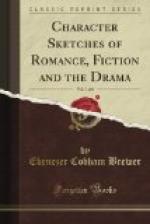BELLERO’PHON was falsely accused by Antea, wife of Proetos, King of Argos, and the enraged husband sent him to Lycia, to King Iobates, the father of Antea, with sealed tablets, asking that the bearer might be put to death. Iobates sent the youth on dangerous errands, but he came off unharmed from all. Among other exploits he killed the Chimaera and slew the Amazons. Later, he tried to mount to Olympus on the winged horse Pegasus, but he fell and wandered about in melancholy madness on the Aleian field until he died. This peculiar form of madness is called morbus Bellerophonteus. Homer tells the story of Bellerophon in the Iliad, Book VI. Milton alludes to him, Paradise Lost, VII. 15-20. Hawthorne has told the story of the Chimaera in A Wonder Book.
BELLE’RUS is the name of a personage invented by Milton as the supposed guardian of Land’s End in Cornwall, the Bellerium of the Romans. In questioning as to where the body of the drowned Lycidas q.v. has been carried by the waves, he asks:
Or whether thou to our moist vows denied
Sleep’st by the fable of Bellerus
old.
Lycidas, 159-60.
BELLE’S STRATAGEM (The). The “belle” is Letitia Hardy, and her stratagem was for the sake of winning the love of Doricourt, to whom she had been betrothed. The very fact of being betrothed to Letitia sets Doricourt against her, so she goes unknown to him to a masquerade, where Doricourt falls in love with “the beautiful stranger.” In order to accomplish the marriage of his daughter, Mr. Hardy pretends to be “sick unto death,” and beseeches Doricourt to wed Letitia before he dies. Letitia meets her betrothed in her masquerade dress, and unbounded is the joy of the young man to find that “the beautiful stranger” is the lady to whom he has been betrothed.—Mrs. Cowley, The Belle’s Stratagem (1780).
BELLE THE GIANT. It is said that the giant Belle mounted on his sorrel horse at a place since called mount Sorrel. He leaped one mile, and the spot on which he lighted was called Wanlip (one-leap); thence he leaped a second mile, but in so doing “burst all” his girths, whence the spot was called Burst-all; in the third leap he was killed, and the spot received the name of Bellegrave.
BELLEUR’, companion of Pinac and Mirabel ("the wild goose"), of stout blunt temper; in love with Rosalu’ra, a daughter of Nantolet.—Beaumont and Fletcher, The Wild Goose Chase (1652).
BELL HAMLYN, young American girl, engaged to one man and in love with another, in Kismet, by George Fleming (Julia C. Fletcher, 1877).
BELLICENT, daughter of Gorlois lord of Tintag’il and his wife Ygerne or Igerna. As the widow married Uther the pen-dragon, and was then the mother of king Arthur, it follows that Bellicent was half-sister of Arthur. Tennyson in Gareth and Lynette says that Bellicent was the wife of Lot king of Orkney, and mother of Gaw’ain and Mordred, but this is not in accordance either with the chronicle or the history, for Geoffrey in his Chronicle says that Lot’s wife was Anne, the sister (not half-sister) of Arthur (viii. 20, 21), and sir T. Malory, in his History of Prince Arthur says:




